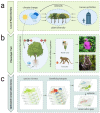Enhancing Conservation Efforts in the Qinling Mountains Through Phenotypic Trait Diversity Optimization
- PMID: 40733367
- PMCID: PMC12300060
- DOI: 10.3390/plants14142130
Enhancing Conservation Efforts in the Qinling Mountains Through Phenotypic Trait Diversity Optimization
Abstract
The establishment of conservation areas is considered one of the most effective approaches to address biodiversity loss with limited resources. Identifying hotspots of plant diversity and conservation gaps has played a crucial role in optimizing conservation areas. Utilizing diverse types of research data can effectively enhance the recognition of hotspots and conservation gaps. Phenotypic trait diversity is a functional biogeography that analyzes the geographic distribution patterns, formation, and reasons for the development of specific or multiple phenotypic traits of organisms. Flower color and fruit color phenotypic traits are primary characteristics through which plants interact with other organisms, affecting their own survival and reproduction, and that of their offspring. This study utilized data from 1923 Phenotypic Trait Diversity Species (PTDS) with flower and fruit color characteristics to optimize conservation areas in the Shaanxi Qinling Mountains. Additionally, data from 1838 endemic species (ES), 190 threatened species (TS), and 119 protected species (PS) were used for validation. The data were primarily sourced from the Catalogue of Vascular Plants in Shaanxi, supplemented by the Chinese Virtual Herbarium and the Shaanxi Digital Herbarium. The results reveal that by comparing the existing conservation area boundaries with those determined by four types of data, conservation gaps are found in 14 counties in the Qinling Mountains of Shaanxi. The existing conservation area only accounts for 13.3% of the area determined by the four types of data. There are gaps in biodiversity conservation in the Qinling Mountains of Shaanxi, and the macroscopic use of plant phenotypic trait data contributes to optimizing these conservation gaps.
Keywords: conservation area; conservation gap; distribution pattern; diversity hotspot; phenotypic traits.
Conflict of interest statement
The authors declare no conflicts of interest.
Figures






Similar articles
-
Behavioral interventions to reduce risk for sexual transmission of HIV among men who have sex with men.Cochrane Database Syst Rev. 2008 Jul 16;(3):CD001230. doi: 10.1002/14651858.CD001230.pub2. Cochrane Database Syst Rev. 2008. PMID: 18646068
-
Short-Term Memory Impairment.2024 Jun 8. In: StatPearls [Internet]. Treasure Island (FL): StatPearls Publishing; 2025 Jan–. 2024 Jun 8. In: StatPearls [Internet]. Treasure Island (FL): StatPearls Publishing; 2025 Jan–. PMID: 31424720 Free Books & Documents.
-
Surveillance for Violent Deaths - National Violent Death Reporting System, 50 States, the District of Columbia, and Puerto Rico, 2022.MMWR Surveill Summ. 2025 Jun 12;74(5):1-42. doi: 10.15585/mmwr.ss7405a1. MMWR Surveill Summ. 2025. PMID: 40493548 Free PMC article.
-
Comparison of the effectiveness of inhaler devices in asthma and chronic obstructive airways disease: a systematic review of the literature.Health Technol Assess. 2001;5(26):1-149. doi: 10.3310/hta5260. Health Technol Assess. 2001. PMID: 11701099
-
Management of urinary stones by experts in stone disease (ESD 2025).Arch Ital Urol Androl. 2025 Jun 30;97(2):14085. doi: 10.4081/aiua.2025.14085. Epub 2025 Jun 30. Arch Ital Urol Androl. 2025. PMID: 40583613 Review.
References
-
- Feehan J., Harley M., Minnen J. Climate Change in Europe. 1. Impact on Terrestrial Ecosystems and Biodiversity. A Review. Agron. Sustain. Dev. 2009;29:409–421. doi: 10.1051/agro:2008066. - DOI
-
- Wang B., Xu G., Li P., Li Z., Zhang Y., Cheng Y., Jia L., Zhang J. Vegetation Dynamics and Their Relationships with Climatic Factors in the Qinling Mountains of China. Ecol. Indic. 2020;108:105719. doi: 10.1016/j.ecolind.2019.105719. - DOI
Grants and funding
LinkOut - more resources
Full Text Sources
Miscellaneous

